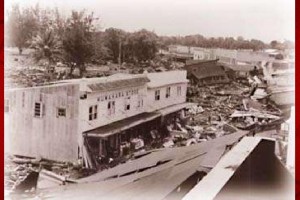‘Tsunami Awareness Month’ Marks 70th Anniversary of 1946 Event

Kuwahara Store was one of the few structures on the ocean side of Kamehameha Avenue in downtown Hilo to survive the 1946 tsunami. Pacific Tsunami Museum file photo.
One of the deadliest tsunamis in Hawai’i struck the Big Island and caused widespread damage to the entire state in April of 1946.
The disaster, which generated from an earthquake in the Aleutian Islands, took 159 lives and caused over $26 million in damage.
Now, in honor and remembrance of the devastating loss and as a reminder to prepare, April is celebrated as Tsunami Awareness Month.
“There is no season for tsunamis,” said Vern Miyagi, Department of Emergency Management Administrator. “During a tsunami threat, people only have hours – sometimes minutes – to move to safety. For this reason, it is crucial that families and individuals have their survival kits ready ahead of time and emergency plans up to date so they can quickly respond and react in a safe and efficient manner.”
Situated in the middle of the Pacific Ocean, Hawai’i has a unique geographical location that makes it vulnerable to the threat of tsunamis.
Earthquakes generated distantly can reach Hawai’i within several hours and are triggered by earthquakes that take place along the Ring of Fire, which circles the Pacific Rim. Meanwhile, locally generated tsunamis caused by earthquakes or volcanic activity that occur in or near the Hawaiian Islands can make landfall in a matter of minutes.
Outdoor sirens will sound across the state for distantly generated tsunamis, however, a locally generated tsunami may not leave time to sound sirens.
HI-EMA warns the public of natural signs that a tsunami may be imminent, including rapidly rising or receding water from the ocean, the sound of a locomotive or jet plane coming from the ocean, and empty beaches.
Those near the ocean when an earthquake takes place should move to higher ground. After hearing warning sirens, the public should tune in to a radio or television for updates and information regarding to potential hazards.
On Saturday, April 16, the Pacific Tsunami Museum in Hilo will host an open house event with free admission to the public.
During the event, PTM will unveil its brand new Science Room, which features an interactive Warning Center Simulation, among other activities.
The Simulation allows guests to jump on a world map and generate an earthquake. From there, the player is faced with several questions that give them a taste of the various factors considered by the real PTWC before making critical decisions, such as issuing a tsunami warning.
















